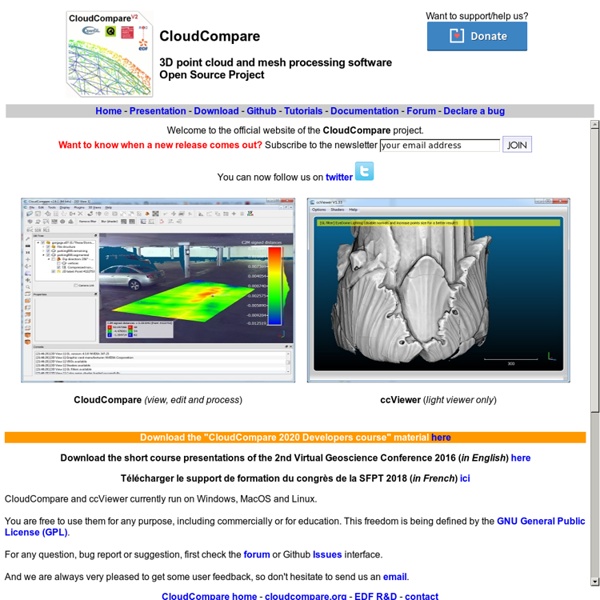



Plugins - CloudCompareWiki From CloudCompareWiki Point-Cloud Processing and Visualization Software - Pointools Quickly visualize, manipulate, animate, and edit point clouds all in a single workflow. This streamlined process helps you decrease production time and increase overall accuracy. Process point clouds for all your infrastructure projects, with Bentley Pointools. High-performance point-cloud engine Fast level of detail, layer-based editing and segmentation of data Professional-quality images, animations, and movies Clash detection Bentley Pointools is powered by Pointools Vortex, the industry’s leading point-cloud engine, which enables the support of very large point clouds. With Bentley Pointools, you can easily import and view three types of objects: Point clouds, which can be imported from a large range of scanners Textured 3D models, which can be imported from a number of common model formats 2D CAD drawings, which can be imported from DXF, DWG, and SHP file formats
From point cloud to BIM Survey software provider Kubit, recently acquired by Faro, goes back to basics with its analysis of the implications and ways of surveyed data capture Figuire 1 Point cloud as reference model: 3D view (left), planar view of the point cloud region (upper right) and the resulting 3D model (lower right) Building Information Modelling (BIM) methodology is increasingly penetrating into building design. The point cloud as reference model First it is necessary to transfer the original survey data into the required BIM system. Besides the spatial display of the whole point cloud it is also additionally possible to use the scan view of the individual scans for modelling. In the scan view all of the surveyed points from a single scanner set up can be displayed in a photo-like panorama view. Figure 2 Using the scan view in the VirtuSurv software (left) for BIM modelling in Autodesk Revit (right) Figure 3 Remodelling in the BIM system: 2D CAD drawings serve as model reference Generalisations vs accuracy
Point Cloud Processing | 3DReshaper | 3DReshaper (Home) 3DReshaper makes accurate and easy points selection from clouds. Clean point clouds automatically and efficiently 3DReshaper® is a tool to process 3D point clouds wherever they come from: 3D scanners, laser scanning, UAVs, or any other digitization device... You can import one or several point clouds whatever their origin and size (see the file formats supported by 3DReshaper). Point cloud preparation is often the most important step to handle in order to save time with the subsequent steps (i.e. meshing). That is why 3DReshaper provides a complete range of simple but powerful functions to process point clouds like: kubit Dresden, Software for Surveying, Construction and Architecture MeshLab ClearEdge 3D - The Leader in Automated Feature Extraction for AEC
Laser scanners : Reconstructor To make more effective the use of the x300, Stonex, has developed a powerful and flexible software called Stonex Reconstructor. The Stonex Reconstructor software is based on the well known JRC 3D Reconstructor ® technology. JRC 3D Reconstructor® is a software package worldwide appreciated for 3D laser scanner data processing in several application fields. Description The software – engineered and powered by Gexcel srl, under Stonex requirements - comes from the convergence of two experiences: the academic know-how of University studies and the applied research achievements of the European Joint Research Centre (JRC), located in Ispra (Italy). The software aim is to turn the latest scientific achievements in the Geomatics field into an hi-tech software for wide application areas. Survey moduleThe fitting solution to capture, process and analyze 3D data of artefacts acquired with X300 scanner.